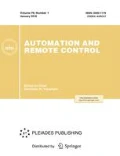Abstract
Consideration was given to a model of the multilevel hierarchical structure whose elements strive to maximize the difference between the stimulation and the costs of managing the subordinated elements by reorganizing the inferior structural part. For different variants of information about the cost functional, solved was the problem of choosing the optimal stimulation that provides an equilibrium structure (where restructuring is not advantageous to the elements) with the minimum total payments.
Similar content being viewed by others
REFERENCES
Burkov, V.N. and Kondrat'ev, V.V., Mekhanizmy funktsionirovaniya organizatsionnykh sistem (Mechanisms of Operation of the Organization Systems), Moscow: Nauka, 1981.
Burkov, V.N. and Novikov, D.A., Teoriya aktivnykh sistem: sostoyanie i perspektivy (Theory of Active Systems: State-of the-Art and Outlooks), Moscow: SINTEG, 1999.
Gubko, M.V. and Novikov, D.A., Teoriya igr v upravlenii organizatsionnymi sistemami (Game Theory in Control of Organization Systems), Moscow: SINTEG, 2002.
Germeier, Yu.B., Igry s neprotivopolozhnymi interesami, (Games with Noncontradictory Interests), Moscow: Nauka, 1976.
Kukushkin, N.S. and Morozov, V.V., Teoriya neantagonisticheskikh igr (Theory of Nonantagonistic Games), Moscow: Mosk. Gos. Univ., 1984.
Grossman, S. and Hart, O., An analysis of the Principal-Agent Problem, Econometrica, 1983, vol. 51(1), pp. 7–45.
Grossman, S. and Hart, O., Implicit Contracts under Asymmetric Information, Q. J. Econom., 1982, no. 1, pp. 110–124.
Hart, O.D. and Holmstrom, B., Theory of Contracts, in Advances in Economic Theory, V World Congress, Cambridge: Cambridge Univ. Press, 1987, pp. 71–155.
Mas-Collel, A., Whinston, M.D., and Green, J.R., Microeconomic Theory, New York: Oxford Univ. Press, 1995.
Novikov, D.A., Mekhanizmy funktsionirovaniya mnogourovnevykh organizatsionnykh sistem (Operational Mechanisms of Multilevel Organization Systems), Moscow: Fond “Problemy Upravleniya,” 1999.
Novikov, D.A., Setevye struktury i organizatsionnye sistemy (Network Structures and Organization Systems), Moscow: Inst. Probl. Upravlen., 2003.
Voronin, A.A. and Mishin, S.P., Algorithms to Seek the Optimal Structure of an Organization System, Avtom. Telemekh., 2002, no. 5, pp. 120–132.
Voronin, A.A. and Mishin, S.P., Modeling the Structure of an Organization System. On Algorithms to Seek the Optimal Tree, Vestn. Volg. Univ., Mat. Fiz., 2001, pp. 78–98.
Voronin, A.A. and Mishin, S.P., A Model of the Optimal Control Structural Changes in an Organization System, Avtom. Telemekh., 2002, no. 8, pp. 136–150.
Voronin, A.A. and Mishin, S.P., Optimal'nye ierarkhicheskie struktury (Optimal Hierarchical Structures), Moscow: Inst. Probl. Upravlen., 2003.
Gubko, M.V., Structure of the Optimal Organization of a Continuum of Agents, Avtom. Telemekh., 2002, no. 12, pp. 116–130.
Dement'ev, V.T., Erzin, A.I., Larin, R.M., et al., Zadachi optimizatsii ierarkhicheskikh struktur (Problems of Optimization of Hierarchical Structures), Novosibirsk: Novosib. Gos. Univ., 1996.
Mishin, S.P., Dynamic Problem of Designing an Optimal Hierarchical Structure, in Upravlenie bol'shimi sistemami (Control of Large Systems), Moscow: Inst. Probl. Upravlen., 2003, vol. 3, pp. 55–75.
Ovsievich, B.I., Modeli formirovaniya organizatsionnykh struktur (Models of Formation of Organization Structures), Leningrad: Nauka, 1979.
Tsvirkun, A.D., Osnovy sinteza struktury slozhnykh sistem (Fundamentals of Designing the Structure of Complex Systems), Moscow: Nauka, 1982.
Aumann, R. and Myerson, R., Endogenous Formation of Links between Players and Coalitions: An Applications of the Shapley Value, in The Shapley Value, Cambridge: Cambridge Univ. Press, 1998, pp. 175–191.
Belleflamme, P. and Bloch, F., Market Sharing Agreements and Stable Collusive Networks, London: Univ. of London, 2002.
Dutta, B. and Mutuswami, S., Stable Networks, J. Econom. Theory, 1997, no. 76, pp. 322–344.
Jackson, M.O. and van den Nouweland, A., Strongly Stable Networks, Eugene: Univ. of Oregon, 2000.
Jackson, M.O. and Watts, A., The Existence of Pairwise Stable Networks, Seoul J. Econom., 2001, vol. 14, no. 3, pp. 299–321.
Jackson, M.O. and Wolinsky, A., A Strategic Model of Social and Economic Networks, J. Econom. Theory, 1996, no. 71, pp. 44–74.
Mesarovich, M.D., Mako, D., and Takahara, Y., Theory of Hierarchical Multilevel Systems, New York: Academic, 1970. Translated under the title Teoriya ierarkhicheskikh mnogourovnevykh sistem, Moscow: Mir, 1973.
Novikov, D.A., Stimulirovanie v organizatsionnykh sistemakh (Stimulation in Organization Systems), Moscow: SINTEG, 2003.
Gubko, M.V. and Mishin, S.P., Optimal Structure of the Control System of Technological Relations, in “Sovremennye slozhnye sistemy upravleniya” (Proc. Int. Conf. “Modern Complex Control Systems), Staryi Oskol, 2002, pp. 50–54.
Novikov, D.A. and Chkhartishvili, A.G., Refleksivnye igry (Reflexive Games), Moscow: SINTEG, 2003.
Vasil'ev, D.K., Zalozhnev, A.Yu., Novikov, D.A., and Tsvetkov, A.V., Tipovye resheniya v upravlenii proektami (Standard Solutions in Project Management), Moscow: Inst. Probl. Upravlen., 2003.
Germei'er, Yu.B. and Novikov, D.A., Obobshchennye resheniya zadach stimulirovaniya v aktivnykh sistemakh (Generalized Solutions of the Stimulation Problems in Active Systems), Moscow: Inst. Probl. Upravlen., 1998.
Lototskii, V.A., Identification of Structures and Parameters of Control Systems, Izmer., Kontr., Avtomatiz., 1991, no. 3–4, pp. 30-38.
Eykhoff, P., System Identification. Parameter and State Estimation, Eindhoven: Univ. of Technology, 1974. Translated under the title Osnovy identifikatsii sistem upravleniya. Otsenivanie parametrov i sostoyanii, Moscow: Mir 1975.
Davies, G., Smith, M., and Twigger, W., Leading People: A Model of Choice and Fate for Leadership Development, Leadership & Organization Development, 1991, vol. 12, no. 1, pp. 7–11.
Jago, A.G. and Vroom, V.H., Perceptions of Leadership Style: Superior and Subordinate Descriptions of Decision-making Behavior, in Leadership Frontiers, Hunt, J.G. and Larson, L.L., Eds., Carbondale: Southern Illinois Univ. Press., 1975, pp. 103–120.
Manz, C.C. and Sims, H.P., Leading Workers to Lead Themselves: the External Leadership of Selfmanaging Work Teams, Administrat. Sci. Quart., 1987, pp. 106–129.
Oldman, G.R. and Hackman, J.R., Relationships between Organization Structure and Employee Reactions: Comparing Alternative Frameworks, Administrat. Sci. Quart., 1981, pp. 66–83.
Peters, T., Thriving on Chaos, New York: Knopf, 1987.
Hardy, G.H., Littlewood, J.E., and Polya, G., Inequalities, London: Cambridge Univ. Press, 1934.
Voronin, A.A., Stable Development-Myth or Reality?, Mat. Obrazovanie, 2000, no. 1(12), pp. 59–67.
Mishin, S.P., Cost of Reorganizing the System Structure, in Tr. kafedry mat. analiza and teorii funktsii Volg. Univ. (Trans. Chair of Math. Anal. Function Theory, Volgograd. Univ.), 2002, pp. 178–198.
Author information
Authors and Affiliations
Rights and permissions
About this article
Cite this article
Mishin, S.P. Optimal Stimulation in Multilevel Hierarchical Structures. Automation and Remote Control 65, 768–789 (2004). https://doi.org/10.1023/B:AURC.0000028324.69867.e4
Issue Date:
DOI: https://doi.org/10.1023/B:AURC.0000028324.69867.e4




